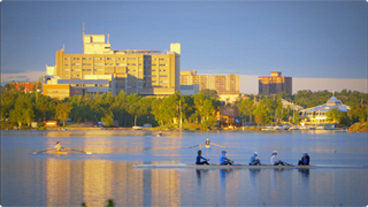A rejuvenated Sudbury now promotes its outdoor recreation. (Photo: Vale)
All this despite the downturn—19,780 Sudburians directly employed in mining and closely related jobs. Local Liberal MP Marc Serré attributes the number to “a globally unique concentration of Canadian hard-rock expertise and innovation, unique in North America and found in very few other cities around the world.” Yet Sudbury was snubbed, he says, when it was ignored by a recent report on industrial clusters in Ontario.
Last week the Institute for Competitiveness and Prosperitycalled on governments to enhance encouragement for clusters such as financial services in Toronto and Ottawa, and the automotive industry in Windsor, Guelph and Kitchener-Cambridge-Waterloo.
Miffed by Sudbury’s exclusion, Serré and the Sudbury Area Mining Supply and Service Association extolled their city’s importance:
-- 5,630 people work in nine underground mines, two mills, two smelters and one nickel refinery that comprise the continent’s largest concentration of mineral sector activity
-- 13,500 people work for 300 Sudbury-area mining supply and service businesses, or about 23,000 people at 500 northern Ontario businesses, which generate around $4 billion in sales in the Sudbury Basin and $5 billion in northern Ontario
-- 400 people work in mineral sector research institutes and schools like Laurentian University, Cambrian College, College Boreal, the Centre for Mining Excellence, NORCAT, the Vale Living With Lakes Centre, Mirarco Mining Innovation, Laurentian Earth Science’s Mineral Exploration Research Centre and others
-- Another 250 people work locally at the Ontario Ministry of Northern Development and Mines, the Ontario Geological Survey and other mining-related ministries
“The richest mining district in North America,” Serré’s communiqué continued, “its unique polymetallic ore bodies not only produce nickel but copper, cobalt, gold, silver, sulphuric acid and platinum group metals.” The Basin is the world’s third-largest producer of PGMs and a significant producer of cobalt, a increasingly vital commodity.
Over 130 years of mining and smelting took its toll on the region, which at one point was often compared to a moonscape. But years of effort have nullified the effect of a 1970s-era ditty:
Only God can make a tree
He’s never tried in Sudbury
As Serré said, “The community has garnered significant international acclaim for its extensive land restoration activities—planting over nine million trees over the past few decades and reducing sulphur dioxide emissions by over 95% from 1970 levels.”
Bruce Jago of the Laurentian Goodman School of Mines added, “The enormous amount of mining and environmental and earth science related research in the Sudbury region—both private sector and government funded—has established the community as a global Silicon Valley of hard-rock mining.”
Snubbed by some, Sudbury’s stature is recognized by others. The previous week the provincial government’s Northern Ontario Heritage Fund announced $5 million in funding over seven years to help support Laurentian University’s mineral exploration research.
And, with another perspective on Sudbury’s mining heritage, here’s Stompin’ Tom Connors…

